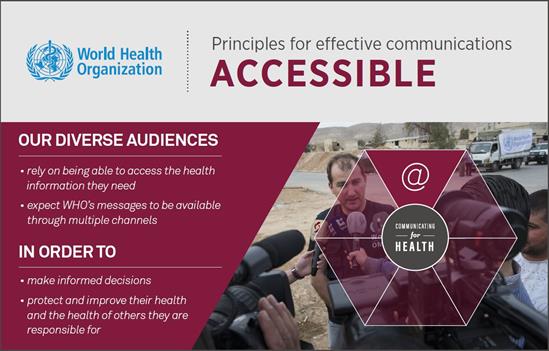
Principle: Accessible
Make information available online
Tactics to apply to make your communications accessible
Make information available online
WHO’s website presents a vast library of trusted information on how to protect health. However, like all websites, WHO’s website is a passive channel of communications. People have to purposely visit the site, search for content and navigate to find topics. Communicators need to develop strategies to draw people to the website, sustain their attention, and make information easy to find.
Place information consistently and purposefully
Strategic placement of website content increases users’ ability to find information (“users” are the people who come to websites to seek information or engage with WHO).
To ensure that people visiting the WHO website find what they need, communicators should take the following points into consideration.
- Establish hierarchy and importance for website content. Critical, high-level information should be placed at the top of the page. Detailed information should be placed at the bottom of the page or hyperlinked.
- Create highly visible locations for the information used most by the target audience. For example, WHO’s website has a Media Centre page for journalists to find content for articles.
- Highlight easy-to-understand information on priority topics.
- Include fact sheets to help users quickly understand the basics on diseases and other health issues.
- Provide links to help users find more detailed information.
Consider how audiences use the website
Visual content on a website sustains user attention and encourages visitors to click through for additional information.
Communicators can use visual elements to ensure key content is highlighted.
- The homepage and landing pages are gateways to the website and to major sections of content. These pages should have text, images and layout that lead visitors to specific topics and materials.
- Infographics on the homepage and landing pages provide quick and easy-to-understand introductions to complex topics.
- Users notice images before headlines. Compelling pictures motivate users to seek more information and make issues resonate at a personal level.
- Human interest photo stories use action-oriented photographs to connect WHO to real-life situations and demonstrate the impact of the Organization’s work.
- Fact files combine 10 facts with 10 photographs to raise awareness of a topic and invite browsers to learn more.
Create emergency specific webpages
An emerging health threat or a sudden onset of a disease outbreak or humanitarian crisis often results in a lot of people seeking information and advice. Decision-makers must have fast access to critical guidance from sources they trust, so it is essential to ensure that information is available immediately and is easy to find. It is also important to provide targeted information addressing the needs of different audiences. WHO communicators have designed consistent layouts for emergency webpages.







